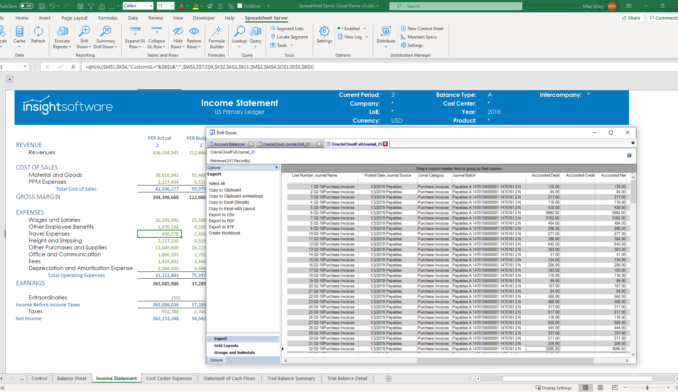Five Ways to Increase Revenue in 2021 with Financial Reporting Tools

As a rule, growth companies understand that technology can be a powerful competitive differentiator. You normally think of technology as being a key enabler of efficiency. It is, to be sure, but software technology also opens the door to new revenue opportunities. As organizations strive to increase revenue, diversify their customer base, and maintain customer loyalty, reporting technology provides an underappreciated key to unlocking value.
Here, we’ll look at five key strategies for expanding revenue in 2021 by leveraging your ERP software and robust financial reporting tools.
1. Empower Your Sales Team
In too many organizations, there is a disconnect between various silos within an organization– between sales and finance, for example, or between sales and supply chain operations. When information fails to pass back and forth efficiently, it can often result in missed sales opportunities.
Consider what happens when a customer tries to place an order for an item that is out of stock. Ideally, sales will have clear visibility into expected delivery dates and can place orders on an available-to-promise (ATP) basis without negatively impacting customer satisfaction. If the ATP numbers are consistently accurate, that works well, but if not, it can result in missed delivery dates, canceled orders, and unhappy customers.
If a company is aware of the problem, it’s possible to alert sales to steer customers toward substitute items. Many modern ERP systems include substitute item functionality. In Microsoft Dynamics 365 Finance & Supply Chain Management (D365 F&SCM), it’s referred to as an alternative item, but the outcome is the same. You’re able to record the sale sooner, and make delivery faster (often from existing inventory), and everyone is happy. Without clear visibility into ATP accuracy and failed delivery dates, however, management may not even be aware that there’s a problem.
How often is the company missing delivery dates because of incorrect ATP numbers, and what is the root cause? Off-the-shelf ERP reports probably don’t give you enough information to fully understand whether it is happening, why it’s occurring, and whether it requires remediation. Those are not complicated questions, but they require a reporting tool that supports that kind of ad hoc inquiry.
A second example involves the link between sales and finance. Top-line revenue is obviously important, but if a customer’s credit history calls into question their ability to pay, the organization stands to lose out on cash collections. The two conflicting interests of sales and cash flow must be carefully balanced.
Consider an organization that sells subscription-based services has taken a proactive approach to working with customers who have a less-than-stellar credit history. The company initially offers short-term contracts to those customers, then offers them extended contract terms over time, as their creditworthiness improves. By closely monitoring the program using custom reports, both the sales and finance departments have clear visibility into the program’s effectiveness.
2. Compliance with Customer Requirements
It’s common for large customers to establish vendor requirements that make it easier for them to manage incoming inventory. Anyone who deals with big-box retailers, for example, has likely implemented Electronic Data Interchange (EDI) as a standard for receiving purchase orders and sending advanced shipping notifications (ASNs) to those customers. Barcoding, likewise, is a common requirement imposed by larger customers.
While those may be very familiar examples, large organizations are increasingly demanding compliance with other standards from suppliers as well. In 2017, Walmart announced its intention to reduce overall CO2 emissions. That effort, which the company calls Project Gigaton, focuses primarily on reducing the company’s carbon footprint via its supply chain. In other words, Walmart will expect its vendors to maintain information on the carbon impact of the products they sell to the company.
Very few ERP vendors have implemented processes within their software to track that kind of information. In the largest, most expensive systems, it is beginning to happen, but for most organizations, the challenge can be addressed with a combination of custom user-defined fields and flexible reporting tools.
Walmart is not the only company imposing such requirements. In the three years since its announcement, several other large companies have launched similar initiatives. Whatever any future requirements might look like, reporting tools can play a critical role in making it possible for organizations to comply.
3. Know Your Customers
Following the initial onset of the COVID-19 pandemic, most companies redoubled their efforts around customer satisfaction, paying special attention to their largest, most profitable customers. As a wave of shutdowns and dramatic fluctuations in demand cascaded through the economy, smart businesses looked at opportunities to diversify revenue and maintain customer loyalty.
Attending to your most valuable customers begins with understanding who those customers are. What do their order volumes look like? Are there seasonal fluctuations? How much profit are those customers driving, and on which products or services? What does their payment history look like?
Standard ERP reports generally aren’t designed to provide that level of depth and nuance. The information exists, sometimes in different locations throughout your organization. When you involve different software systems, getting a holistic picture of your customers can be difficult. Nevertheless, it’s critical for customer-focused businesses to have that visibility. Robust reporting tools make it possible.
Good access to customer information opens up new opportunities as well. Just a few years ago, it was commonplace to hear business leaders lament the fact that only 20% of their marketing spend was effective, but that, unfortunately, they didn’t know which 20% it was.
In the digital economy, that situation has changed dramatically. While it still may be difficult to measure the effectiveness of media advertising and direct mail, digital marketing has created massive new potential for reaching customers with highly targeted messages and then quickly evaluating the effectiveness of those campaigns.
A new breed of CRM tools has arisen to provide a framework for digital marketing automation. Nevertheless, many companies still operate ERP and CRM as functional silos. As a result, there are untapped opportunities to identify purchasing patterns and common needs across subsets of customers and to build revenue-generating marketing campaigns (or even new products and services) that can meet those customers’ requirements.
The right reporting tools can serve as a catalyst to align information across many different silos within the organization. When business leaders can see beyond the barriers that divide systems (such as ERP and a strong digital marketing automation platform), they gain visibility to new revenue opportunities.
4. Integration with eCommerce
Online commerce has exploded since the arrival of COVID-19. Even before the pandemic, many forward-looking companies were already bolstering their ecommerce capabilities. For those with a limited online presence, however, the coronavirus was a mandate for change.
Most ERP vendors have adopted a best-of-breed integration approach to ecommerce, giving customers the flexibility to adopt one or more of the many available online selling platforms. That provides flexibility, and in some cases opens up new marketplace opportunities for sellers (via Amazon or eBay, for example), but it also makes it difficult to establish clear visibility into product sales and profitability across those platforms.
Using the canned reporting tools provided by each ecommerce platform vendor leaves businesses with a highly fragmented view of their online business. By bringing data together under one roof, then normalizing that data so that it provides an apples-to-apples comparison, business leaders can gain clear insights into all their sales activity, across every sales channel, including ecommerce.
5. Better Visibility to Performance
Finally, and perhaps most importantly, effective reporting tools provide clear visibility of key performance metrics across the entire organization. Now more than ever, it is critical that business leaders understand what’s happening in real time.
If your supply chain is not operating efficiently, if back-orders are piling up, or if customer quotes are not turning into purchase orders, management needs to know that. While the standard reports that come with ERP and CRM often provide routine baseline information, they fall short when it comes to measuring the distinct numbers and characteristics that are unique to each enterprise.
The capability to perform ad hoc queries, asking the questions that are unique to your organization, and getting answers that reflect accurate, up-to-date information from your ERP, CRM, and other systems is the key to managing your business in a rapidly changing world.
Reduce Your Dependency on Manual Reporting Processes
For most organizations, reporting consumes too much staff time because it requires tedious manual processes like copying and pasting information from exported CSV files or system reports, or entering information by hand into Excel spreadsheets.
Those kinds of processes also introduce errors, leading to a lack of confidence in the information being reported. Business leaders consistently express frustration at the difficulty of getting clear information out of their software systems in a timely way. When an organization has clear, accurate, timely information based on real-time data, everyone in the business can operate according to a single version of the truth. That means the management team can spend less time arguing about the numbers, and more time solving problems and improving business results.
insightsoftware provides financial and operational reporting tools that connect to over 140 different ERP systems, including D365 F&SCM. For nearly three decades, we have been helping business leaders get the information they need quickly, accurately, and efficiently to drive higher levels of financial intelligence and boost revenue. If your organization is aiming to increase revenue in the coming year, contact us today to get a live demo.










